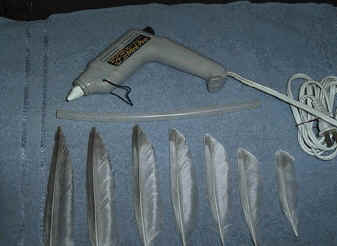 |
 |
"Lots of people talk to animals,
not to many listen - that's the problem" Winnie the Pooh
We received a phone call from a concerned citizen about a Blue Jay "that can't
fly despite flapping a whole bunch". We were told that she had caught the bird
and had it in her bathroom while seeking help for the injured Jay. We told her she
could drop it off at the Long Beach Animal Hospital and
we would do everything possible to heal this bird so it could be released once healthy.
When we received the bird, we found that it wasn't a Blue Jay as reported but
actually a Kingfisher. The bird was strong and healthy with the only abnormality being it
had lost 4 of its primary flight feathers. The breakage of these feathers rendered the
bird flightless and it would therefore have starved to death before the feathers could
re-grow. Thanks to the intervention of this animal lover, the Kingfisher has a chance to
live.
With the Jay's condition, we had 2 paths which we could take to returning the bird to a
healthy condition . The first option would be to house the Kingfisher in captivity until
the feathers re-grew and replaced the feathers that were broken. This would entail
long term captivity, which would be detrimental to the "wildness" of the bird;
plus it would also be very stressful to such a beautiful, wild creature. Our second
option, and the one we chose for obvious reasons, was to implant feathers onto the broken
primary feathers. We call this process "imping". This procedure would
allow the Kingfisher to be ready for release in just a couple of days.
The first task in imping is to find donor feathers. These feathers would need to come from
a donor that was approximately the same size as the recipient. The first possible donor we
received was a crow, but Crows and Kingfishers are natural enemies, which raised the
question of how the Kingfisher would react having Crow feathers and how would other
Kingfishers accept the Kingfisher with Crow feathers. Our next possible donor was a
Common Gull. The bird was the proper size but the feathers to be imped were in very poor
condition so we continued our wait for a proper donor. In a couple of days we
received a Gull that would be the perfect donor, the perfect size and all the feathers
were in excellent condition.
 Before we started, we assembled all the equipment we would need to
perform the imping. These tools included a hot glue gun, razor/scalpel blade, inserts and
the donor feathers. The donor feathers are cut to the proper size for the recipient
bird and are marked, enabling quicker identification and placement once the procedure is
started.
Before we started, we assembled all the equipment we would need to
perform the imping. These tools included a hot glue gun, razor/scalpel blade, inserts and
the donor feathers. The donor feathers are cut to the proper size for the recipient
bird and are marked, enabling quicker identification and placement once the procedure is
started.
To attach the donor feather to the recipient's feather, an insert is used. I
personally prefer to use the shaft from a feather that has been selected by diameter
size and shaved down to the bare quill. It is this bare quill that is cut to the proper
length and inserted into feather shafts. 
This page was last updated:
May 27, 2016
All information is the sole property of All Wildlife Rescue and Education, Inc.
Problems,
questions or comments about the site: Webmaster@awre.org